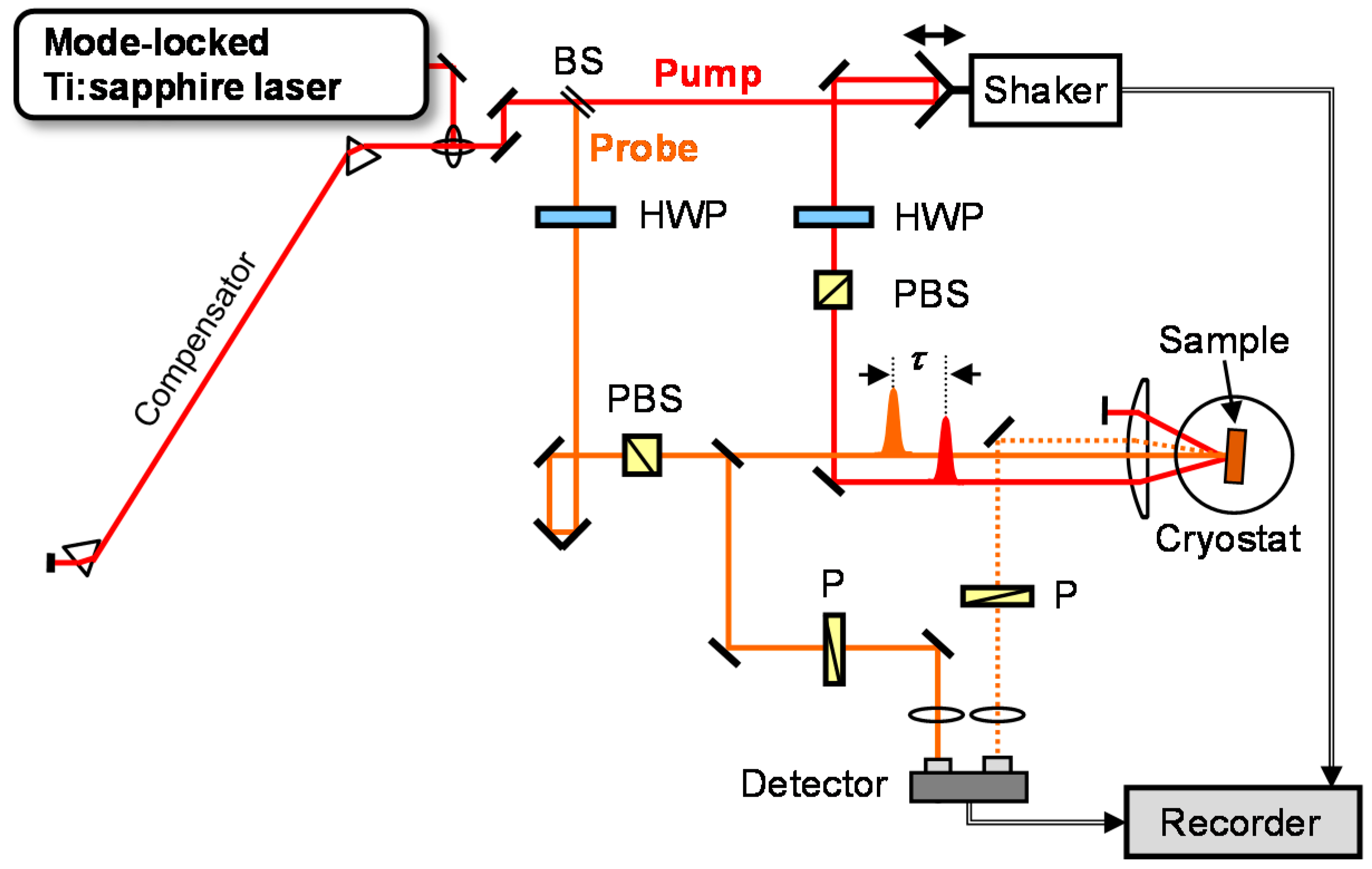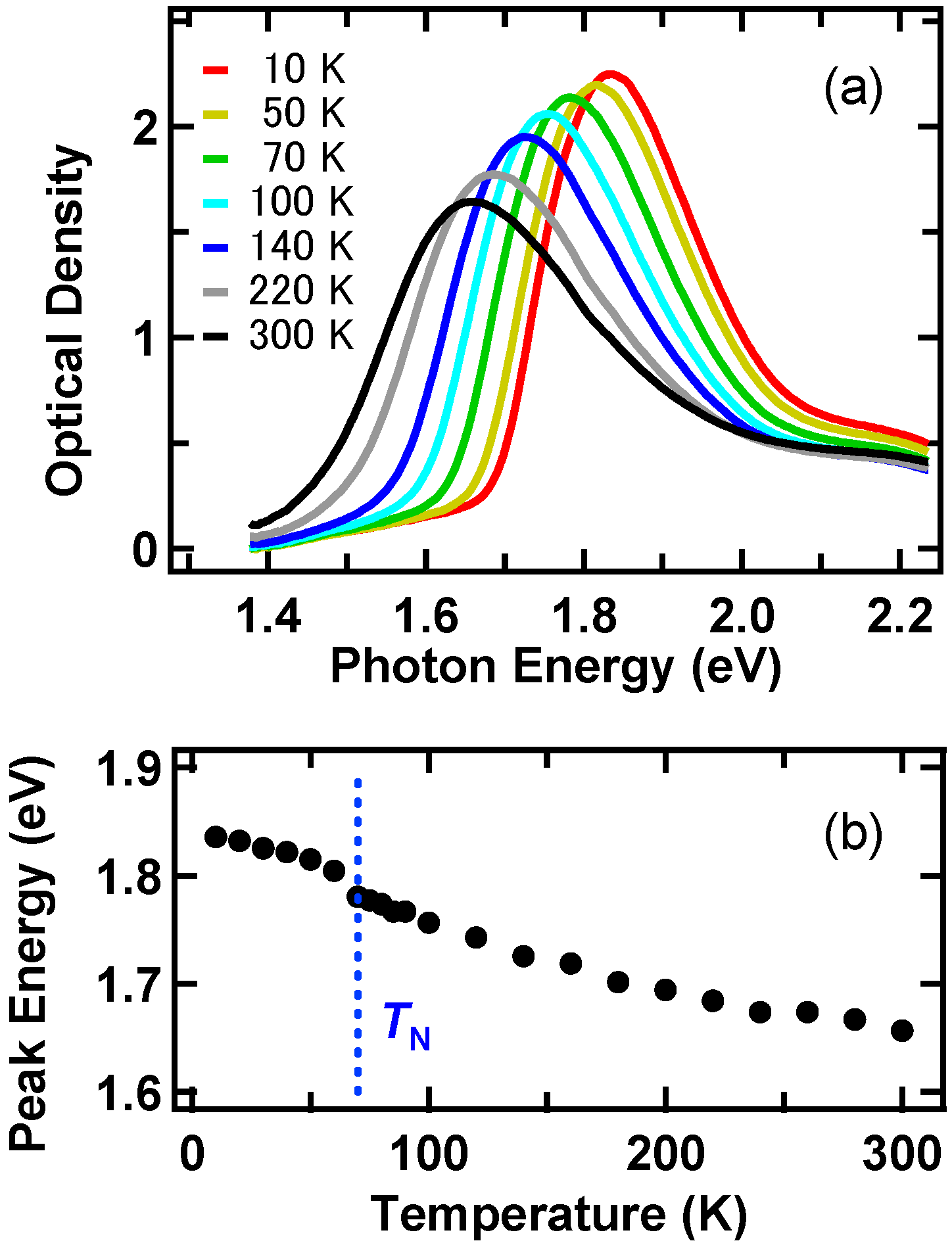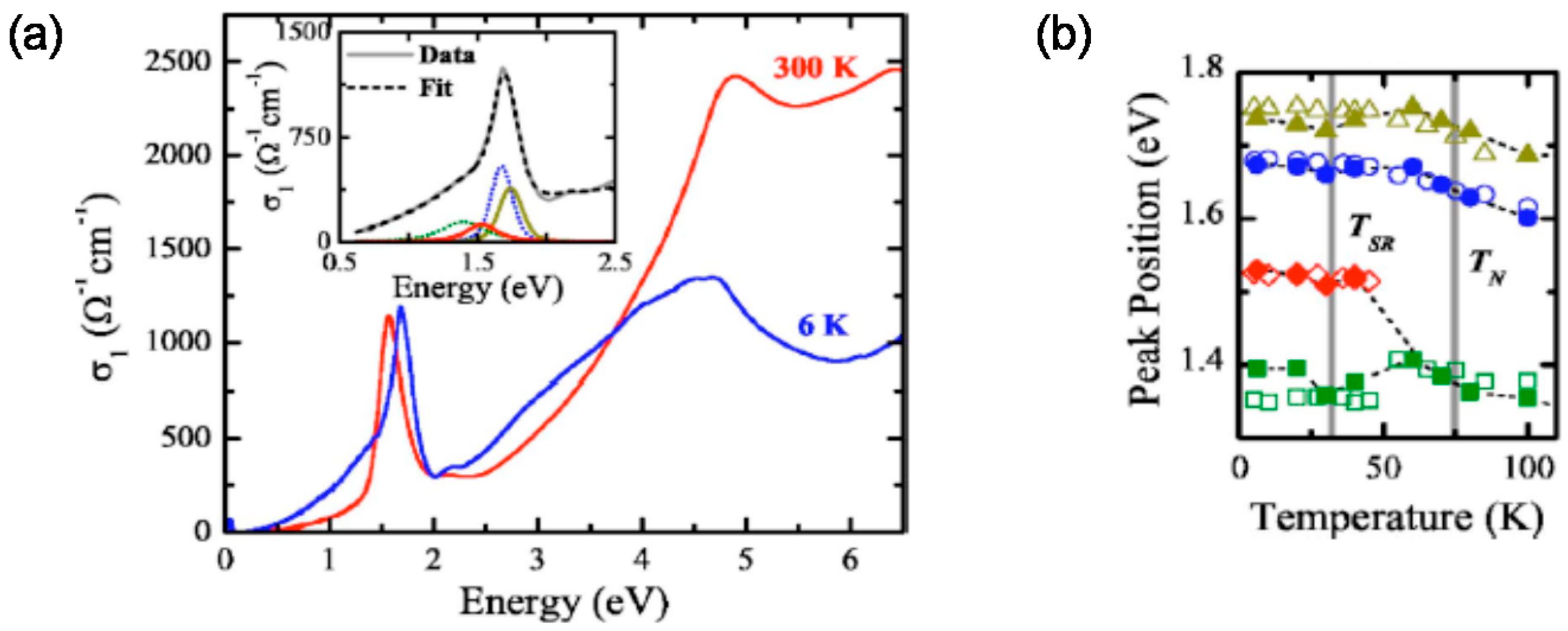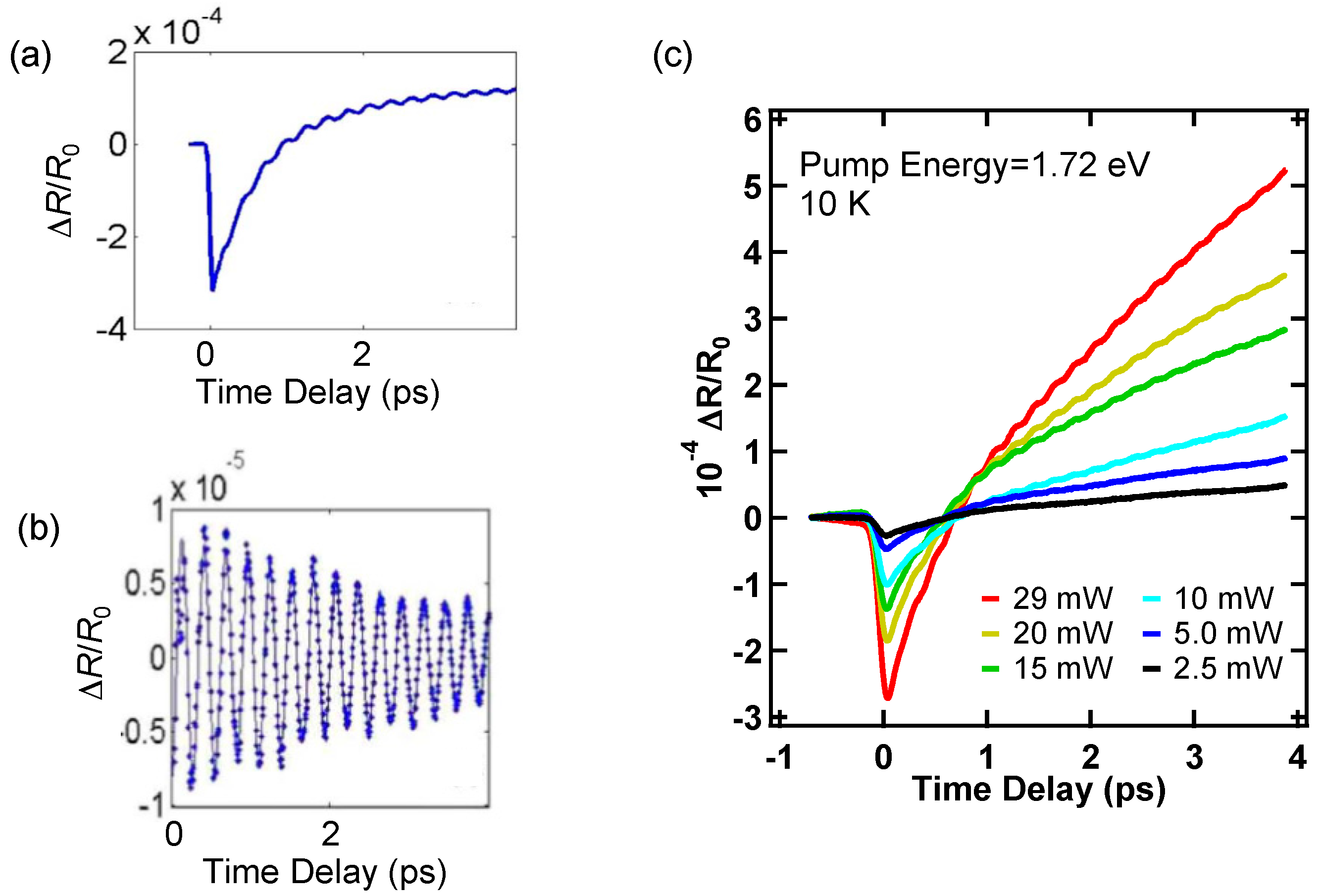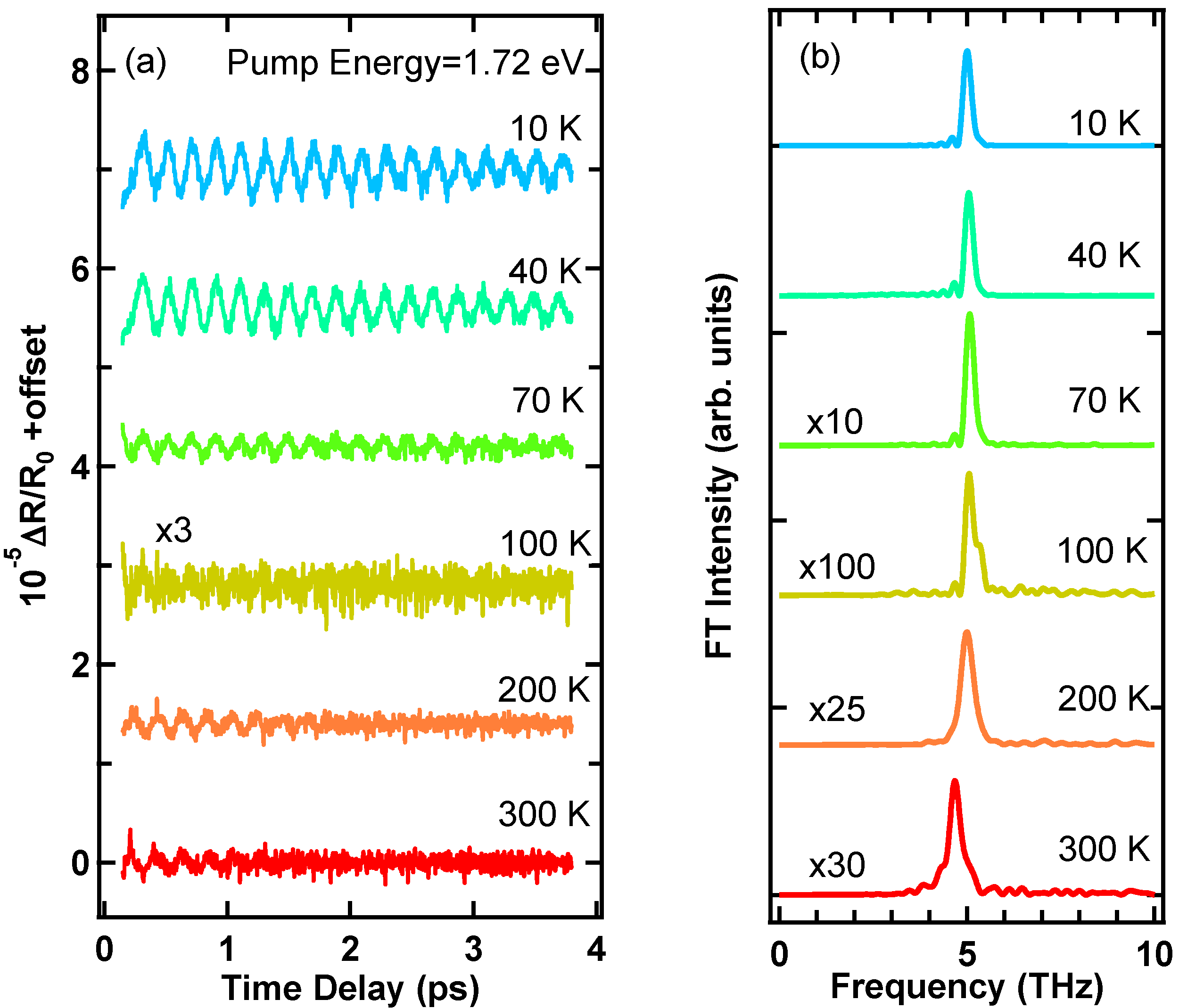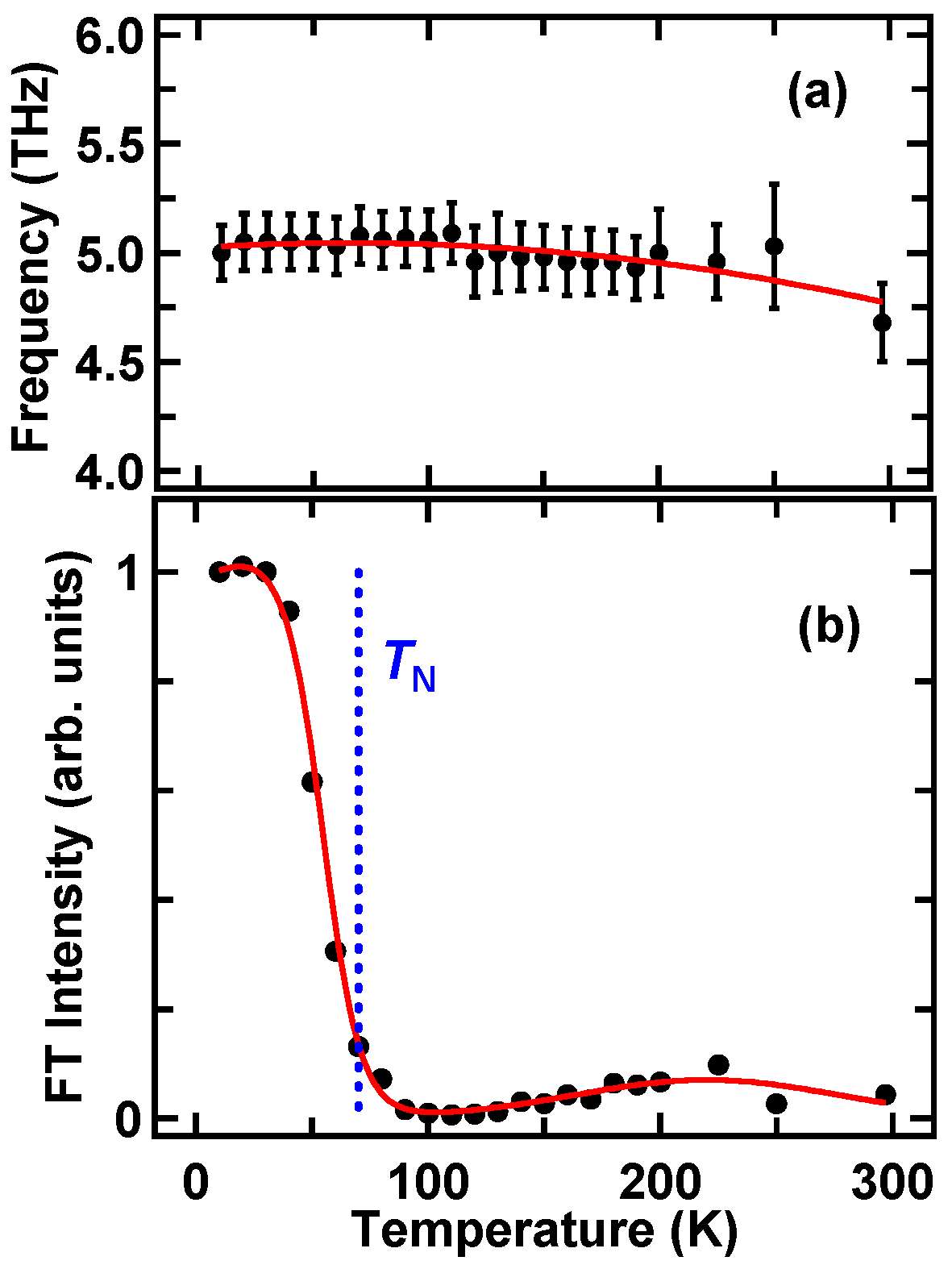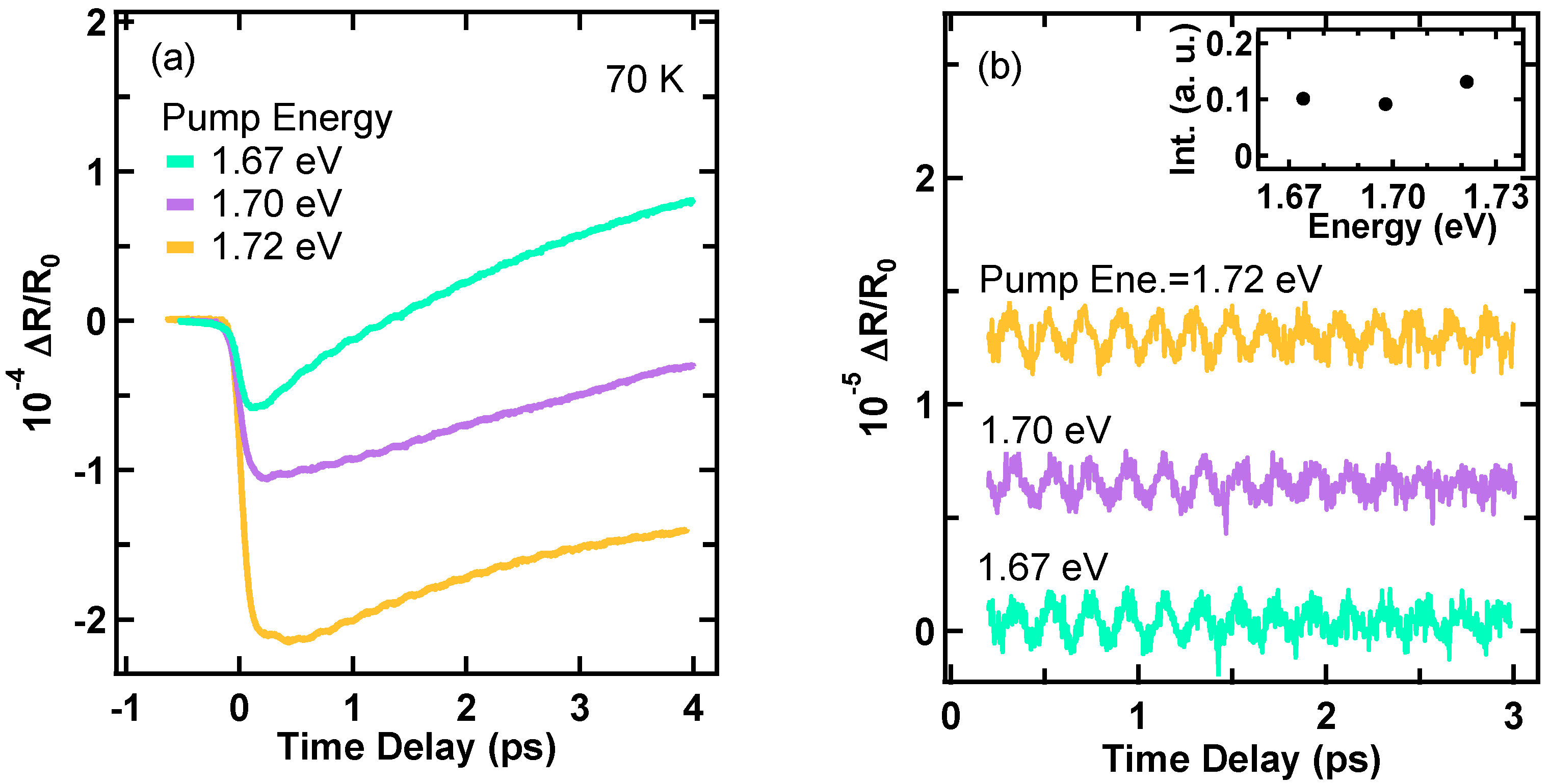4.1. Optical Transition Property
First, we describe optical transition properties in
RMnO
3.
Figure 2a shows the absorption spectra at different sample temperatures in a hexagonal YMnO
3 thin film with the thickness of ~300 nm epitaxially grown on a (111) MgO substrate by pulsed laser deposition [
35,
36]. A strong absorption band is observed at each temperature. The profile is consistent with previous reports of an absorption spectrum [
37] and imaginary part of a dielectric function [
38]. In hexagonal
RMnO
3, the crystal field of
D3h symmetry splits Mn 3d orbitals into two e
1g (
xz,
yz) orbitals, two e
2g (
xy,
x2 −
y2) orbitals and a
1g (3
z2 −
r2) orbital. The e
1g and e
2g are occupied states while a
1g is unoccupied state. Accordingly, the optical transitions occur from the e
1g and e
2g states to a
1g state [
39]. It is widely considered that the absorption peak at ~1.7 (2.3) eV is originated from the optical transition from the e
2g to a
1g (e
1g to a
1g) states [
12,
37,
39]. The absorption band shows a lower energy shift with an increase in temperature. The peak energy of the absorption band is plotted in
Figure 2b as a function of temperature, where the vertical dashed line indicates the Néel temperature: ~70 K [
20]. The amount of the lower-energy shift is ~0.18 eV as increasing temperature from 10 to 300 K. In the pump-probe experiment with a fixed pump photon energy, we have to pay strict attention to this energy shift because the initial distribution of excited electron states can be changed by temperature; the feature of the initial distribution could affect ultrafast responses of the electron and phonon systems. Wu et al. measured ∆
R/
R0 signals as a function of temperature in various YMnO
3 epitaxial films and estimated the energy gaps from the signal amplitude around the time origin [
40]. Similarly, the effect of the absorption band shift is emerged in our study, which is discussed in
Section 4.4.
In
Figure 2b, the absorption peak shows an abrupt change around the Néel temperature. Such anomalies of absorption peak shifts were observed in hexagonal
RMnO
3 thin films with
R = Gd, Tb, Dy, Ho and Lu [
12]. These anomalies are attributed to that the electronic state is modulated by the antiferromagnetic ordering. On the other hand, in order to rigorously analyse the temperature-dependent peak shift, the line-shape analysis of the absorption band considering several absorption bands would be required.
Figure 3a shows the optical conductivity spectra at 6 K and 300 K in a hexagonal HoMnO
3 single crystal [
41]. The inset shows a fitted result of the spectrum at 6 K considering four components. The four components were considered to be due to the transitions from two e
2g states to a
1g state and from two e
1g states to a
1g state.
Figure 3b shows the peak positions of each component as a function of temperature. The temperature dependence of the peak energy is different from each other, which suggests the complexity of the mechanism of the absorption band shift. Moreover, the fitted result indicates that the band at ~1.7 eV is composed of at least two components (striking one at ~1.7 eV and weak one in a lower-energy range). The absorption spectra in
Figure 2a may have similar components because it shows a similar asymmetric profile.
4.2. Observation of Coherent Optical Phonons
Hereafter, we describe the results of pump-probe experiments. The observation of a coherent optical phonon in LuMnO
3 was first reported by Lou et al. [
22]. They used reflection-type pump-probe spectroscopy with 20-fs optical pulses at room temperature. The pump photon energy was 1.55 eV, which is near the absorption peak of Mn
3+ d-d transitions.
Figure 4a shows the ∆
R/
R0 signal in a LuMnO
3 single crystal at room temperature, where the pump and probe pulses were irradiated to the (0001) face. The signal shows a V-shaped profile with an oscillatory structure. The oscillatory signal extracted from
Figure 4a is shown in
Figure 4b. The frequency was evaluated to be ~3.6 THz. From measurements of the polarization dependences of pump and probe pulses on the oscillation and discussion based on related Raman tensors, the oscillatory signal was assigned to the coherent optical phonon with
A1 symmetry. The coherent phonon signal shows a cosine shape, which indicates that the coherent phonon is generated by the DECP mechanism. In addition, the sharp drop of the ∆
R/
R0 signal around the time origin was discussed. They interpreted it as the change in absorption of the optical transition between e
2g to a
1g states.
Figure 4c shows the ∆
R/
R0 signals in the YMnO
3 thin film at different pump powers measured at 10 K. The pump photon energy was tuned to 1.72 eV that is sufficiently higher than the absorption edge. The ∆
R/
R0 signal has a V-shaped curve and an oscillatory structure, which are similar to those in
Figure 4a. The ∆
R/
R0 signal can be decomposed into three components; a fast spike component, slowly-varying component and oscillating component. Wu et al. comprehensively analysed the ∆
R/
R0 signal in YMnO
3 epitaxial films using by the following equation [
40]:
where the first to forth terms on the right-hand side correspond to the non-thermal electronic response, incoherent electron-phonon interaction, magnetization dynamics and coherent acoustic phonon oscillation, respectively. The non-thermal electronic response is originated from dense excited states, which quickly decays within 1 ps. The fast spike component in
Figure 4c corresponds to the first term. The second term is a slow positive component. The thermalization process of electron and phonon systems has a fast rise time (
τs1) of ~1 ps while the decay time (
τ2) is few hundreds of picosecond. The third term is a slow negative component associated with the perturbation of the antiferromagnetic ordering due to the optical transition [
25]. The disordering time (
τs2) and reordering time (
τ3) are few ps and few hundreds of picosecond, respectively. The slow component in
Figure 4c shows a positive value in all the pump powers. Accordingly, the incoherent electron-phonon interaction (second term) would be dominant. The oscillation period of acoustic phonons is few tens of picosecond [
21,
23,
25], which is much longer than the time window of
Figure 4c. A clear oscillatory signal of acoustic phonons is observable with a longer time window. In the present ∆
R/
R0 signal, the acoustic-phonon signal may contribute to the rise of the slow components.
Figure 5a shows the ∆
R/
R0 signals in the YMnO
3 thin film at different pump photon energies at 10 K. We tuned the pump photon energy to 1.63, 1.67 and 1.72 eV with the same pump power of 20 mW. We note that the optical density of the absorption band becomes lower as decreasing the pump photon energy from 1.72 to 1.63 eV. In the ∆
R/
R0 signals at 1.67 and 1.72 eV, the contribution of the photoexcitation is obvious from the striking fast and slow components. On the other hand, both polarities of the fast and slow components at 1.67 eV are different from those of the signal at 1.72 eV. The polarity reversal of the fast component was observed in the pump photon energy dependence around the band gap [
40]. Based on Equation (1), the negative slow component at 1.67 eV corresponds to the magnetization dynamics. This fact implies that the excitation of lower energy region (the low-energy weak component) in the absorption band leads to the strong perturbation of the magnetic ordering and/or the reduction of the incoherent electron-phonon interaction.
Figure 5b shows the oscillatory signals with the subtraction of the fast and slow components. The amplitude of the oscillatory signal strongly depends on the pump photon energy. In order to analyse the oscillatory signals, we fitted the signals by a damped harmonic oscillation curve:
Aexp(−
t/
τp) cos(
ωt +
φ), where
A,
ω/2
π,
φ and
τp are the amplitude, frequency, phase and decay time of the oscillation, respectively. The fitted result of the oscillatory signal pumping at 1.72 eV with 20 mW is shown in
Figure 6a as an example. All the oscillatory signals were well fitted by the oscillation curve. This means that the oscillatory signal is composed of a single-frequency mode. The estimated frequency is ~5.1 THz (~170 cm
−1), which is independent on the pump photon energy and power. This frequency almost agrees with the lowest-frequency one of optical phonon modes with
A1 symmetry in hexagonal YMnO
3 crystals observed by Raman spectroscopy [
17,
19,
20], where the calculated frequency of the longitudinal mode is the same frequency as the transverse mode [
28]. The observed coherent optical phonons in LuMnO
3 are the lowest-frequency mode with A
1 symmetry [
22,
24]. Moreover, the generation mechanism was assigned to DECP. As described in
Section 2, the photoexcitation of electrons is essential to the DECP mechanism. Moreover, the amplitude of the coherent phonon generated by DECP tends to proportional to the pump power corresponding to the number of photoexcited electrons [
42].
Figure 6b shows the pump photon energy dependence of
A, where the bar indicates FWHM of the pump pulse spectrum. The dashed curve indicates the absorption spectrum at 10 K. The amplitude clearly shows the relation to the amount of photoexcitation.
Figure 6c shows the pump power dependence of
A. The amplitude is proportional to the pump power as indicated by the solid line. The coexistence of both properties shown in
Figure 6b,c is consistent with the characteristics of the coherent phonon generated by the DECP mechanism. These facts demonstrate that the oscillatory signal is originated from the lowest frequency coherent optical phonon with A
1 symmetry generated by the DECP mechanism.
4.3. Temperature Dependence of Coherent Optical Phonons
The temperature dependence of phonon modes in YMnO
3 has intensively investigated by Raman spectroscopy [
17,
19,
20] and infrared spectroscopy [
18]. The temperature-dependent shift of the phonon frequency is the main concern; several phonon modes exhibit anomalies around the Néel temperature. This behaviour could be affected by the spin-lattice coupling that is relevant to the electromagnetic effect. Thus, the investigation of the coherent optical phonon as a function of temperature is extremely important. Here, we describe the characteristics of the temperature dependence of the coherent optical phonon.
Figure 7 shows the ∆
R/
R0 signals in the temperature ranges from 10 to 90 K (a) and from 100 to 300 K (b) under the fixed pump photon energy of 1.72 eV. The oscillatory signals of the coherent optical phonon are discernible at several temperatures. Moreover, the fast and slow components show a strong temperature dependence, which is discussed in
Section 4.4.
Figure 8a shows the time-domain oscillatory signals numerically extracted from the ∆
R/
R0 signals in
Figure 7. The amplitude of the coherent phonon strongly depends on the temperature. We performed the Fourier transform (FT) of the time-domain oscillatory signals to precisely evaluate the temperature dependence of the coherent phonon. The calculated FT power spectra are shown in
Figure 8b. The peak frequency and intensity of the FT band depend on the temperature.
First, we discuss the temperature dependence of the peak frequency.
Figure 9a shows the peak frequency of the FT spectrum as a function of temperature, where the length of the bar corresponds to FWHM of the FT band. The solid curve is a guide to the eye. The peak frequency has a small temperature dependence. The frequency shift is ~0.3 THz (~10 cm
−1) as increasing from 10 to 300 K. The total amount of the shift almost agrees with that of the peak shift of the corresponding Raman spectrum [
17]. In contrast to previous Raman studies, the anomaly of the frequency shift around the Néel temperature is unidentified in
Figure 9a. The possible reason is that the accuracy of the estimated frequency is insufficient to observe the anomalous behaviour around the Néel temperature because of the intensity drop of the oscillation as described in the next paragraph. The slight broadening of the FT band is seen with increasing temperature. It is attributed to a build-up of energy relaxation processes of the optical phonon.
The FT intensity of the coherent optical phonon exhibits a complex temperature dependence. The integrated intensity of the FT band is plotted in
Figure 9b as a function of temperature together with the Néel temperature (70 K) as the vertical dotted line, where the solid curve is a guide to the eye. It is indicated that the FT intensity decreases as the temperature increases to the Néel temperature from 10 K. The intensity has a minimum value at ~100 K and then it slightly recovers in a higher temperature range. The change in intensity of coherent phonons around the Néel temperature has reported in hexagonal
RMnO
3 compounds with
R = Y, Lu and Ho [
23,
24,
25,
26]. On the other hand, they reported that coherent phonons are completely damped when the temperature passes through the Néel temperature. In contrast to these reports, the present coherent optical phonon can be observed in the temperature range from 10 to 300 K including the Néel temperature. Thus, the present data is of great importance for understanding the characteristics of the coherent phonon dynamics in hexagonal
RMnO
3 compounds.
The intensity of the coherent phonon generated by the DECP mechanism reflects the population of excited states. As described in
Figure 2, the absorption band has the strong temperature dependence. Accordingly, the population of photogenerated electrons can be changed by temperature under the fixed pump photon energy of 1.72 eV. The amount of the lower energy shift of the absorption peak is ~50 meV as increasing temperature from 10 to 70 K, while the profile of the absorption band is almost unchanged. Therefore, we simply evaluated the contribution of the absorption band shift to the coherent phonon intensity by decreasing the pump photon energy by 50 meV at 70 K.
Figure 10a shows the ∆
R/
R0 signals at the pump photon energy of 1.67, 1.70 and 1.72 eV at 70 K, where the maximum of the pump photon energy difference, 50 meV, corresponds to the energy shift of the absorption peak from 10 to 70 K. The time-domain oscillatory signals extracted from the ∆
R/
R0 signals are shown in
Figure 10b, where the right-side inset shows the integrated intensities of the FT band of the time-domain oscillatory signals. It is evident that the pump-photon energy dependence of the FT intensity is negligibly small in comparison with the temperature dependence of that from 10 to 70 K as shown in
Figure 9b. This fact demonstrates that the intensity drop of the coherent optical phonon around the Néel temperature is not related to the temperature dependence of the absorption band.
It is considered from the above discussion that the change in intensity of the coherent optical phonon is related to the antiferromagnetic ordering. In YMnO
3, the Y atom is nonmagnetic while the Mn atom is directly related to the magnetic property. It is noted that the A
1-symmetry optical phonon includes only the vibrations of Y atoms [
28]. It seems strange that the oscillation intensity of the A
1-symmetry optical phonon correlates with the antiferromagnetic ordering. This behaviour can be explained by the isostructural transition around the antiferromagnetic ordering as follows [
14]. As decreasing temperature to the Néel temperature from a higher temperature range, Mn atoms displace from their ideal positions to get antiferromagnetic ordering and the other atoms also displace within the unit cell. The variation of the atom positions can change the characteristics of phonon properties. In YMnO
3, there are two types of Y atoms locating at different lattice sites. The displacements of two Y atoms are not identical as a function of temperature, whereas they have extrema values at the same temperature of ~90 K. This temperature almost agrees with the temperature at which the oscillation intensity of the coherent optical phonon has the minimum value. On the assumption that the relative amount of the displacement of Y atoms from their position at 10 K corresponds to the decrement of the intensity of the coherent optical phonon, the dip-shaped dependence in
Figure 9b can be qualitatively explained. Accordingly, the change in intensity of the coherent optical phonon around the Néel temperature is considered to be originated from the spin-lattice coupling under the isostructural transition.
The comparison of the temperature dependences of the coherent optical phonons in YMnO
3 and LuMnO
3 exhibits an interesting aspect. The temperature dependence of a coherent optical phonon in LuMnO
3 was reported by Jang et al. [
24].
Figure 11a shows the temperature dependence of the ∆
R/
R0 signal in a LuMnO
3 film observed by reflection-type pump-probe spectroscopy with 20-fs pulses. The ∆
R/
R0 signal shows an oscillatory structure at several temperatures. The frequency of the oscillatory structure was estimated to be ~3.6 THz by the FT analysis. From the frequency, the oscillation was assigned to the lowest-frequency coherent optical phonon.
Figure 11b shows the image map of the FT amplitude spectrum as a function of temperature. The frequency is slightly decreased with an increase in temperature, which is similar to
Figure 9a. The image map shows that the amplitude has a maximum value at ~200 K and is completely damped in a temperature range below the Néel temperature (~90 K). We note that this behaviour is oppositely different to
Figure 9b: the intensity strongly decreases in a temperature range above the Néel temperature. The opposite behaviour could be originated from the property of the isostructural transitions; namely, the displacement direction of Mn atoms in YMnO
3 is opposite in comparison with that in LuMnO
3 [
14]. We believe that the difference of the isostructural transition properties leads to the distinct temperature dependence of the coherent optical phonon.
There are several reports on the temperature dependence of coherent acoustic phonons in
RMnO
3 compounds [
21,
23,
24,
25]. The generation process of observed acoustic phonons was considered to a propagating strained layer mechanism [
43]. Lim et al. studied the oscillation period, phase and decay time of a coherent acoustic phonon as a function of temperature in a LuMnO
3 film [
21]. They found that the phase steeply changes near the Néel temperature. It is originated from a sudden change in complex refractive index around the d-d transition energy. Jang et al. studied the temperature dependences of coherent acoustic phonons in YMnO
3 [
23] and LuMnO
3 films [
24]. The amplitudes of coherent acoustic phonons in both samples have a maximum value around 190 K and disappear below the Néel temperature, which is similar to that of the coherent optical phonon in
Figure 11b. On the other hand, the frequency of that in LuMnO
3 does not show a monotonous change as a function of temperature. Moreover, when the temperature is well below the Néel temperature in both samples, another oscillatory structure with a different frequency appears. Such intriguing behaviours would lead to further studies on the phonon dynamics in a picosecond range.
4.4. Ultrafast Incoherent Responses of Excited Electron States
We discuss the temperature dependence of incoherent responses of excited electron states. Jin et al. studied the temperature dependence of a time-resolved transmittivity change in a YMnO
3 film [
37]. The signals were fitted by a double exponential decay curve, where the faster and slower decay components were interpreted as electron-lattice thermalization and spin-lattice interaction, respectively. The time constant of the slower component show a peculiar behaviour at ~120 K, which was considered to be due to a short-range spin ordering. Shih et al. reported the temperature dependence of the ∆
R/
R0 signal in a HoMnO
3 single crystal [
25]. They fitted the ∆
R/
R0 signal by using an equation that is similar to Equation (1). Most important finding is that the amplitude of the negative slow component shows a clear correlation to the position shift of Mn atoms as a function of temperature under the isostructural transition. Accordingly, ultrafast incoherent responses also offer a clue for deeper understanding of coupling phenomena. As shown in
Figure 7, the fast and slow components have strong temperature dependences. In a lower temperature range, the signal has a V-shaped profile, while it gradually becomes L-shaped profile with an increase in temperature. The temperature at which the signal profile completely changes to L shape is ~80 K. This behaviour seems like the emergence of the correlation with the antiferromagnetic ordering. However, at 70 K, the signal profile recovers from the L shape to V shape by decreasing the pump photon energy as shown in
Figure 10a. It is noted that the profile of the 1.67 eV-pumping signal at 70 K is roughly consistent with that of the 1.72 eV-pumping signal at 10 K shown in
Figure 5a. As described above, the peak energy of the absorption band is decreased by ~50 meV as increasing temperature from 10 to 70 K. These facts indicate that the signal profile is determined by the energy difference between the pump photon energy and absorption band peak. As described in
Figure 2, the absorption band suggests multiple components. Therefore, the distribution of photogenerated electrons strongly depends on the pump photon energy around the absorption band peak. Thus, the strong temperature dependence in
Figure 7 is dominated by the temperature-dependent shift of the absorption band. The systematic study on the pump photon energy relative to the absorption band peak is essential to the investigation of incoherent response dynamics.
